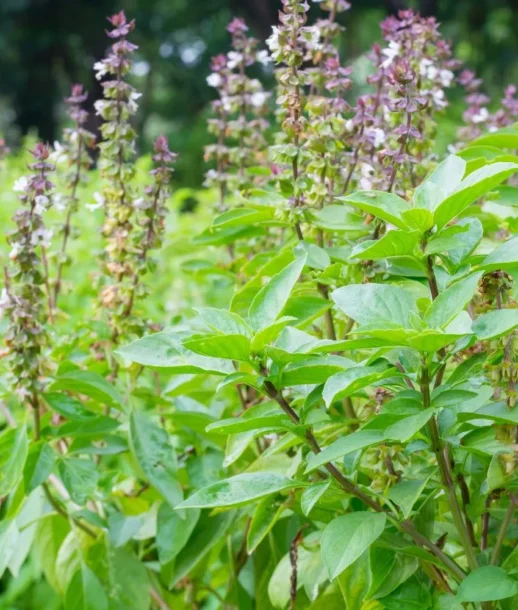Ocimum tenuiflorum, commonly known as holy basil, tulsi, or Tulasi, is an aromatic perennial plant in the family Lamiaceae. It is native to tropical and subtropical regions of Asia but is now widely cultivated throughout the world.
Holy basil is a small, bushy plant with green or purple leaves and small, white or purple flowers. It has a strong, pungent smell and a slightly minty Flavor.
Holy basil has a long history of use in traditional medicine, particularly in Ayurveda. It is believed to have a wide range of health benefits, including:
- Boosting the immune system
- Reducing inflammation
- Relieving stress and anxiety
- Improving digestion
- Reducing Fever
- Protecting against heart disease
- Reducing blood sugar levels
- Fighting cancer cells
Holy basil can be consumed in a variety of ways, including:
- Fresh leaves can be added to salads, soups, and other dishes.
- Dried leaves can be used to make tea or infusions.
- Holy basil extract can be added to capsules, tablets, and other dietary supplements.
- Holy basil is generally safe for most people to consume, but it is important to talk to your doctor before using it, especially if you have any underlying health conditions or are taking any medications.
- Ocimum tenuiflorum is an aromatic perennial plant in the family Lamiaceae. It is native to tropical and subtropical regions of Asia but is now widely cultivated throughout the world.
Botanical description:
- Habit: Erect, many-branched subshrub, 30-60 cm (12-24 in) tall
- Stems: Four-sided, purplish, and hairy
- Leaves: Broadly elliptical, with a slightly toothed margin; 1.5-6 cm long, 1-2.5 cm wide; pubescent on both surfaces, but especially on the nerves beneath
- Flowers: Pink or white, tubular and 2-lipped; small clusters of 3 flowers arranged in pairs along a spike-like, racemose inflorescence (8-10 cm long)
- Fruits: Composed of 4 tiny, one-seeded nutlets
Additional characteristics:
- Holy basil has a strong, pungent smell and a slightly minty flavor.
- The leaves are arranged in pairs, with adjacent pairs perpendicular to one another.
- The Flowers are pollinated by small bees.
- Holy basil is relatively drought-tolerant and can thrive in a variety of soil conditions.
Uses: Holy basil is a popular herb used in traditional medicine and cooking. In traditional medicine, holy basil is used to treat a wide range of conditions, including respiratory infections, digestive problems, and skin conditions.
In cooking, holy basil is used to flavor curries, soups, and other dishes.
Cultivation:
- Holy basil is easy to grow from seed.
- The seeds can be sown directly in the ground in the spring, after the last Frost.
- Holy basil plants should be spaced 12-18 inches apart.
- Holy basil plants prefer full sun and well-drained soil.
- Holy basil plants can be harvested throughout the growing season. The leaves can be used fresh, dried, or frozen
Safety:
- Holy basil is generally safe for most people to consume.
- However, it is important to talk to your doctor before using holy basil, especially if you have any underlying health conditions or are taking any medications.
- Holy basil can interact with certain medications, such as blood thinners and diabetes medications.
Ocimum tenuiflorum, also known as holy basil or tulsi, contains a wide range of chemical constituents, including:
- Essential oils: The essential oil of holy basil is rich in eugenol, methyl eugenol, linalool, caryophyllene, and other terpenoids.
- Phenolic acids: Holy basil contains a variety of phenolic acids, including rosmarinic acid, caffeic acid, and ferulic acid.
- Flavonoids: Holy basil contains a variety of flavonoids, including apigenin, luteolin, and quercetin.
- Other constituents: Holy basil also contains other constituents, such as triterpenes, sterols, and tannins.
The chemical constituents of holy basil vary depending on the variety of the plant, the growing conditions, and the extraction method used. However, the constituents listed above are generally considered to be the major components of holy basil.
The chemical constituents of holy basil are responsible for its many health benefits. For example, eugenol has anti-inflammatory and analgesic properties, while rosmarinic acid has antioxidant and anti-cancer properties.

